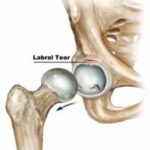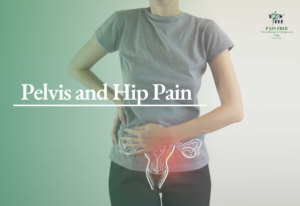
Pelvic Girdle
The pelvis is formed by two symmetrical bones known as the innominate bones or pelvic bones/ hip bone. The innominate bones of both sides articulate anteriorly (on the front) at the pubic symphysis and posteriorly with the sacrum at sacroiliac joints on either sides. This together as a unit is known as pelvic girdle (the bony structures that attaches the axial skeleton to the lower limbs).
The innominate bone has three articulations–
- Sacroiliac joint – articulation with sacrum.
- Pubic symphysis – articulation with the corresponding hip bone.
- Hip joint – articulation with the head of femur.

The pelvic bone has three parts – the ilium, pubis and ischium.
 2
2
Hip Joint
The hip joint is a ball and socket synovial joint formed by an articulation between the pelvic acetabulum and the head of the femur.
It connects the lower limb to the pelvic girdle, and thus is designed for more stability and weight-bearing than movement.
The acetabulum is a cup-like depression located on the inferolateral aspect of the pelvis. The cavity of acetabulum is deepened by the presence of a fibrocartilaginous rim known as acetabular labrum. The head of femur is hemispherical, and fits completely into the concavity of the acetabulum.
Both the acetabulum and head of femur are covered by thick articular cartilage being a weight bearing joint.
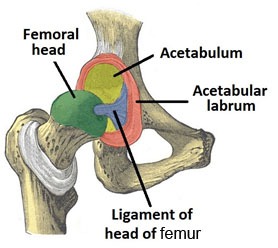
Ligaments of Hip joint:
The ligaments of the hip joint act to increase stability. They can be divided into two groups – intracapsular and extracapsular:
Intracapsular–
Ligament of head of femur is the only intracapsular ligament. It runs from the acetabular fossa to the fovea of the femur. It encloses a branch of the obturator artery (artery to head of femur) within itself.
Extracapsular–
There are three main extracapsular ligaments, continuous with the outer surface of the hip joint capsule:
- Iliofemoral ligament – spans between the anterior inferior iliac spine and the intertrochanteric line of the femur. It has a ‘Y’ shaped appearance, and prevents hyperextension of the hip joint
- Pubofemoral ligament – spans between the superior pubic rami and the intertrochanteric line of the femur. It has a triangular shape, and prevents excessive abduction and extension.
- Ischiofemoral ligament – spans between the body of the ischium and the greater trochanter of the femur. It has a spiral orientation, and prevents excessive extension.
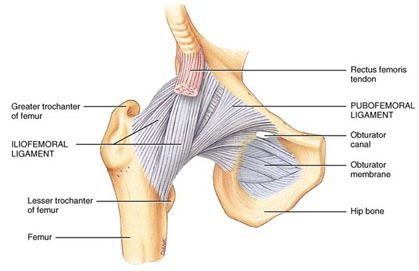
SACROILIAC JOINT
The sacroiliac (SI) joint is the joint connecting the spine and the pelvis. It is a large diarthrodial joint made up of the sacrum and the two innominate bones of the pelvis.
The main function of the SI joint is to provide stability and transfer forces to the lower extremities. The strong ligamentous system of the joint makes it better designed for stability and limits the amount of motion available.
Ligaments of SI joint:
The ligaments stabilizing the SI joint are the strongest ligaments in the body. They consist of:
- Anterior Sacroiliac ligament – this is an anteroinferior thickening of the fibrous capsule that is weak and thin when compared to the other ligaments of the joint.
- Interosseous Sacroiliac ligament – it forms the major connection between the sacrum and the innominate and is a strong, short ligament deep to the posterior sacroiliac ligament. It resists anterior and inferior movement of the sacrum.
- Posterior Sacroiliac ligament – it connects the PSIS with the lateral crest of the third and fourth segments of the sacrum and is very strong and tough. Nutation (anterior motion of the sacrum) loosens the ligament and counternutation (posterior motion) makes the ligament taut.
- Sacrotuberous ligament – this consists of three large fibrous bands and is blended with the posterior sacroiliac ligament. It stabilizes against nutation of the sacrum and counteracts against posterior and superior migration of the sacrum during weight bearing.
- Sacrospinous ligament – its triangular shaped and thinner than the sacrotuberous ligament and goes from the ischial spine to the lateral parts of the sacrum and coccyx and then to the ischial spine laterally. Along with the sacrotuberous ligament, it opposes forward tilting of the sacrum on the innominate bones during weight bearing.
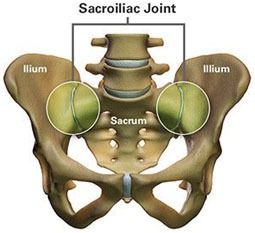
Numerous conditions can affect the hip and pelvis. Hip and pelvis pain may be caused by traumatic injury or certain medical conditions. Pain in this region may range from simple muscular strain to serious underlying condition that requires medical intervention. However the simpler ones are more common type of hip and pelvis pain which respond well to conservative physiotherapy treatment.
Fractured of hip or pelvis can cause extreme hip and pelvic pain. The pelvic fractures are rare and can range from minor to marked in severity. The time to heal depends on the site, severity and displacement of fractured fragments. Major pelvic fractures can endanger a person’s life and damage the bladder, intestines and rectum. It can be classified as stable or unstable. Stable pelvic fractures involve one break point, minimal bleeding and no bone displacement. Unstable pelvic fractures have two or more pelvic breaks, along with significant bleeding. Common signs and symptoms associated with pelvic fractures include pain in the groin, hip and lower back, abdominal pain, numbness and tingling in the groin or legs and difficulty urinating, walking or standing. A hip fracture is more come due to severe traumatic blow to the site in young patients while in elderly it can crack following trivial trauma due to osteoporosis. This requires immediate intervention. Orthopedic surgeon is the most suitable person to consult.
There are various forms of arthritis and related conditions that can affect the hip joint, muscles and/or bones can cause hip pain, stiffness and swelling.
Some uncommon types of hip arthritis are discussed in brief below
Juvenile arthritis – Juvenile arthritis begins before the age of 16. There are several different types of juvenile arthritis. This can affect hip and other joints and cause arthritis type of symptoms.
Lyme disease – this is an infectious disease characterized by skin rash, joint swelling and flu-like symptoms. The disease is caused by the bite by a tick infected with a bacterium called B. burgdorferi. Lyme disease can affect the hip joint.
Lupus – Lupus is a chronic autoimmune disease, wherein the body’s own immune system creates antibodies that damage healthy tissues. Lupus can cause inflammation of the joints, including the hip, as well as the skin, heart, lungs, and kidney.
Gout – Gout (is a form of arthritis) occurs due to excess uric acid (a bodily waste product circulating in the bloodstream) is deposited as needle-shaped monosodium urate crystals in tissues of the body, mainly the joints. The first symptom of gout is excruciating pain and swelling in the big toe or ankle, often without any trauma, illness or injury. The painful joints are more likely to have urate crystal deposition. Subsequent attacks may occur off and on in other joints, primarily those of the foot and knee. Gout less commonly causes hip pain.
Psoriatic arthritis – This form of arthritis is accompanied by the skin disease psoriasis. The skin disease latter affects the joint. In a very small percentage the joint disease develops before the skin disease. The arthritis can affect both large and small joints, including the hip.
Infectious arthritis – It is also called septic arthritis; infectious arthritis refers to arthritis that is caused by an infection within the joint. Infectious arthritis is often cause by bacteria that spread through the bloodstream to the joint. Sometimes it is caused by viruses or fungi.
Polymyalgia rheumatica – It is an inflammatory disorder that causes widespread muscle pain and stiffness. Polymyalgia rheumatica mainly affects the neck, shoulders, upper arms, thighs and hips. The disease often comes on suddenly and resolves on its own in a year or two.
Paget’s disease of the bone – This is a chronic disorder in which excessive breakdown and formation of bone at the same time causes the bones to become enlarged and weakened. It usually does not affect the entire skeleton. If the pelvis is affected the disease can cause hip pain.
Some other more common forms of hip and pelvic pain, related to different structural involvement and location of pain can be discussed under following sub-headings
Types of Hip Joint Pain
- Hip Arthritis – Osteoarthritis
- Labral Tear (hip)
- Hip pointer
- Femoroacetabular Impingement – FAI
- Perthes Disease
- Slipped Femoral Capital Epiphysis
- Stress Fracture
- Avascular Necrosis of the Femoral Head
Lateral Hip Pain
Groin Pain – though conditions like hip arthritis, systemic arthritis, SI joint strain, and other hip joint pain conditions can be potential cause of pain in groin region. Few commoner ones are mentioned below –
- Adductor Tendinopathy
- Groin Strain
- Osteitis Pubis
- Inguinal hernia
- Sportsman’s hernia
- Iliopsoas bursitis/ tendonitis
SI Joint dysfunction/ strain
Systemic Diseases
Other common affections in this region–
- osteoporosis
- fibromyalgia
- Piriformis Syndrome
- Muscle Pain – Muscle Strain
- DOMS – Delayed Onset Muscle Soreness
- Cramps
- Lower Back Pain – can radiate pain in gluteal region, around hip and sacrum.
- Nerve entrapment
- Sciatica
Pelvic Floor Conditions
- Stress incontinence
- Urge incontinence
- Urgency (overactive bladder)
- Antenatal care
- Postnatal care
- Vaginal prolapse
- Pelvic pain
- Faecal incontinence
- Bowel conditions (e.g. constipation).
If You or Anyone you know is going through any of the above conditions of Pelvis and Hip Pain, Consult today with our Physiotherapist to know what needs to be done. Have Queries or want to make an appointment ?




